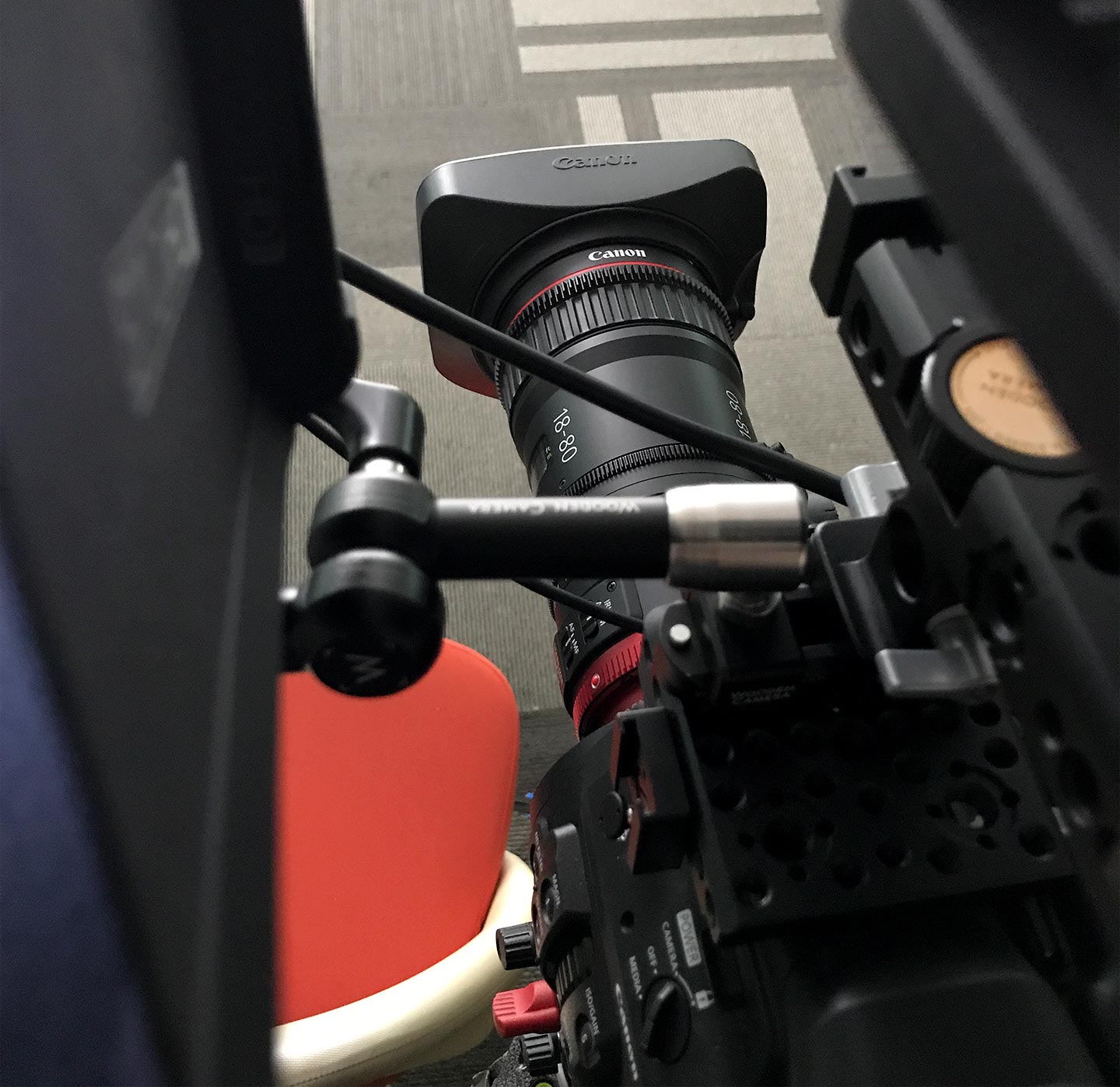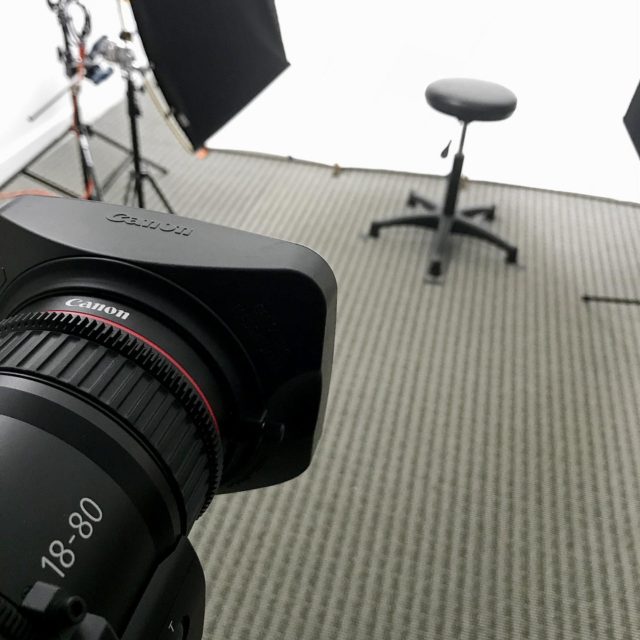
I have had Canon’s new compact servo lens, the CN-E 18-80mm T4.4, for a year now and I love it. So much so that If you follow me on Instagram you’ve seen the lens peppered throughout my BTS images. It has become my go-to lens for most situations.
I’m not going to go into everything about the lens here, as one would do in a full review, but instead concentrate on what I think I can add to the conversation.
A quick test of the Canon CN-E 18-80mm T4.4 handheld on a Canon C300 Mark II (YouTube link):
A recent interview I filmed with the CN-E 18-80mm T4.4 at f/4 and 44mm focal length on the Canon C300 Mark II (YouTube link):
The CN-E 18-80mm has become my go-to lens because of its image quality, its ease of use, and its focal range. I film a lot of interviews, a lot of b-roll for those interviews, and many client b-roll libraries. In the past it would take many L glass zooms to complete those projects. I often drew from the 16-35mm f/4L IS, the 24-70mm f/2.8L II, the 24-105mm f/4L IS, and the 70-200mm f/2.8L IS II.
The issues with these lenses and their use in video production is that they are above all stills lenses. They were never designed for video. None of them are parfocal, they cannot zoom smoothly without extra equipment, they are all harder to focus than cinema lenses, and some of them are not true fixed aperture zooms (I’m looking at you 24-105mm f/4).

The CN-E 18-80mm Compact Servo lens in comparison corrects all of those faults and more. It can replace almost all of the stills zoom lenses I mentioned. In practical terms, with its 4:1 zoom range it is great for wide establishing shots and all the way through to isolated shots of subjects or in highlighting details.
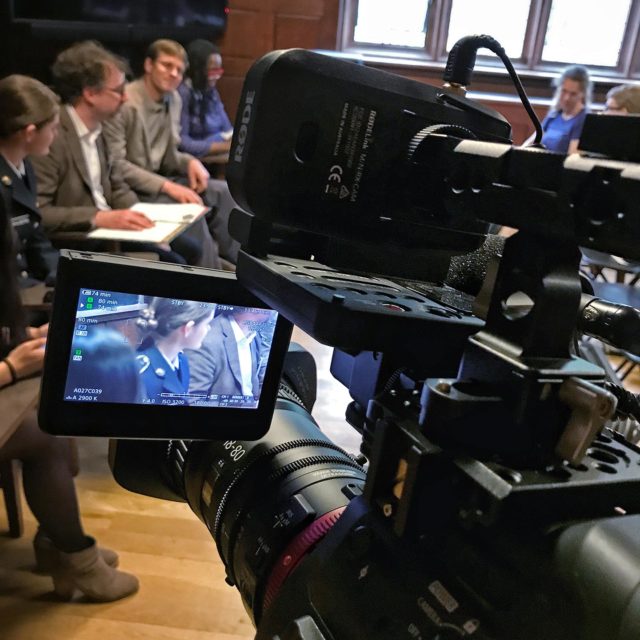
I should note that the CN-E 18-80mm is designed for Super35 cinema cameras. It does not have full-frame 35mm coverage. The 18-80mm range on Super35 is the equivalent of ~24mm-120mm on a full-frame 35mm sensor.
Being parfocal, the CN-E 18-80mm holds focus as you zoom and it is a true T4.4 (f/4 equivalent) through and through. The image will not darken or lighten based on the lens’ focal length.
The CN-E 18-80mm also has image stabilization which is fine-tuned to video, something that is lacking in older stills lens designs. It has three modes; A, B, and C. A, “normal”, is a traditional amount of IS for when the camera is handheld but used to track other objects; B, “heavy”, is for when the camera itself is moving a lot in addition to the subject; and C, “tripod”, is a dampened IS for tripod based work. Mode C will not show the drift or sponginess typical of using an image stablized stills lens.
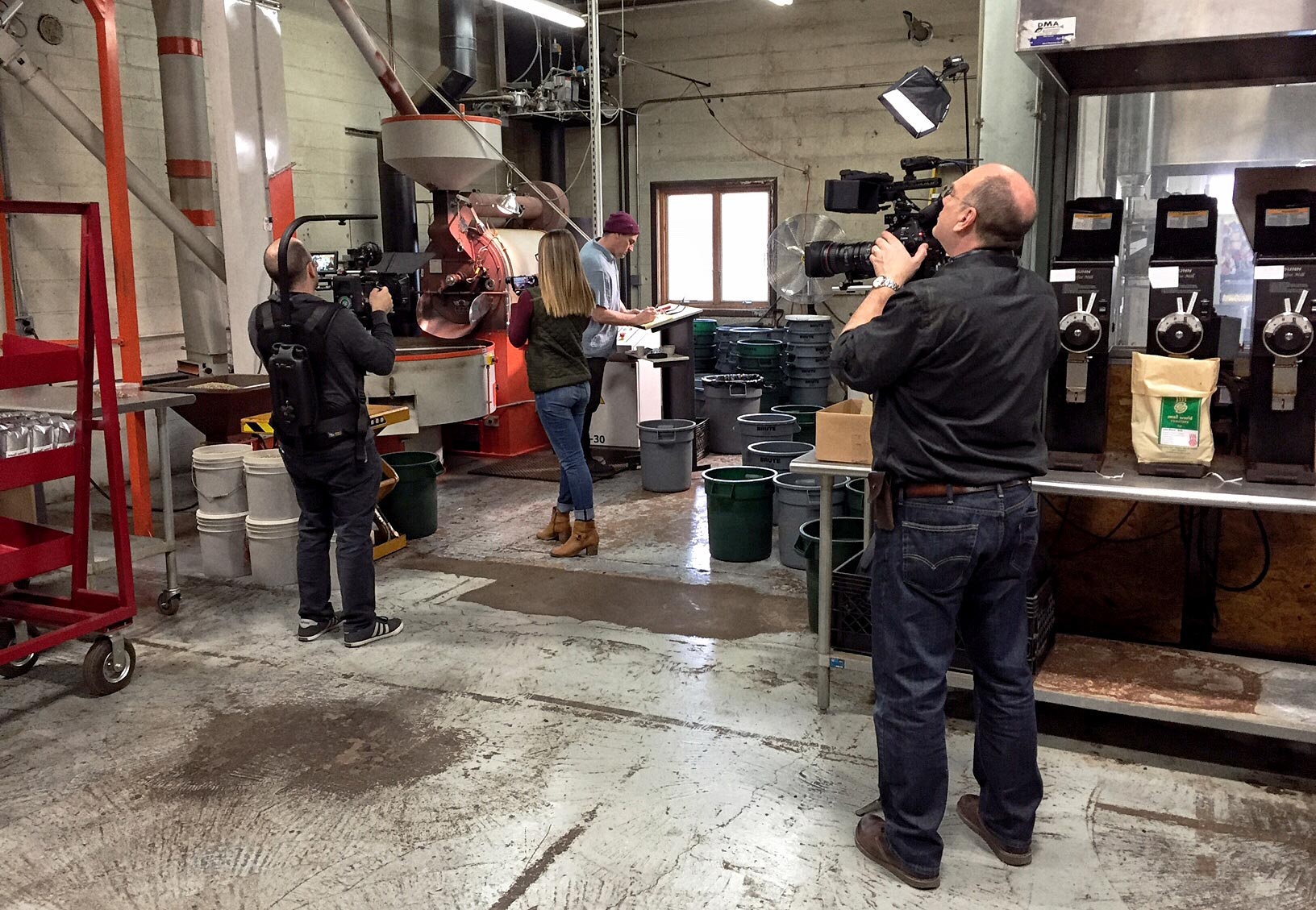
Lens Breathing can be a factor when using stills lenses for video. It refers to a change in the image size within the frame as one racks focus from near to far or vice versa. If the breathing is bad, it can be disconcerting to the viewer and ruin a clip. The CN-E 18-80mm has a bit of breathing at its wide end but it is extremely limited and it disappears completely by about 20mm.
The video below is a lens breathing comparison of the CN-E 18-80mm lens vs. stills zoom lenses with overlapping focal ranges: the 16-35mm f/4L IS, the 24-70mm f/2.8L II, and the 70-200mm f/2.8L IS II. As seen in the video the stills zoom lenses all exhibit noticeable amounts of breathing.
Lens test: The Canon Compact-Servo CN-E 18-80mm T4.4 Lens Breathing vs other Canon L Zooms (YouTube link):
The lens breathing test above also clearly shows another difference between the CN-E 18-80mm and Canon L glass, the CN-E 18-80mm lens is warmer. This is due to its design. It is made to match Canon’s family of CN-E Cinema EOS lenses. You can mix the CN-E 18-80mm lens with L glass, you will just need to do a little extra in post to match the color.
Visible, too, in the test and confirmed by my extensive use of the lens, the CN-E 18-80mm as part of its mojo draws scenes differently than most other Canon L glass. Objects within its frame are better delineated. I suspect it is due to how the lens handles micro or local-contrast within a scene.
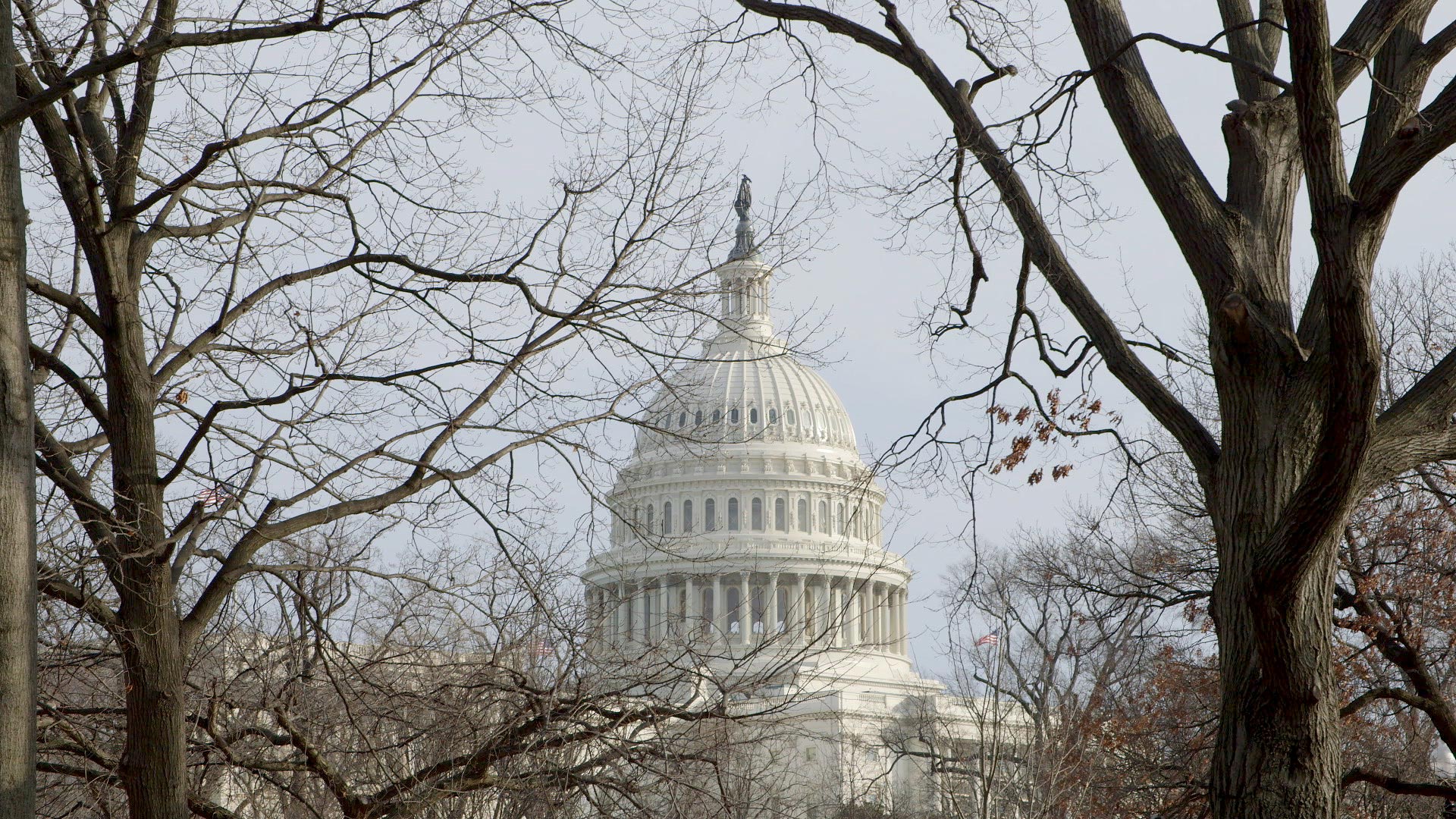
There is one optical characteristic of the CN-E 18-80mm that can be seen in the lens breathing test that I would like to point out. At 18mm, it does have some barrel distortion. That distortion clears very quickly as you zoom in but it is something to be aware of if you are filming in a situation where you need a wide rectilinear image. In that case you might want to opt for Canon’s 16-35mm f/4 L IS lens or its TS-E 17mm and TS-E 24mm II shift lenses (I have not tested Canon’s CN-E wide primes to see how they distortion.)

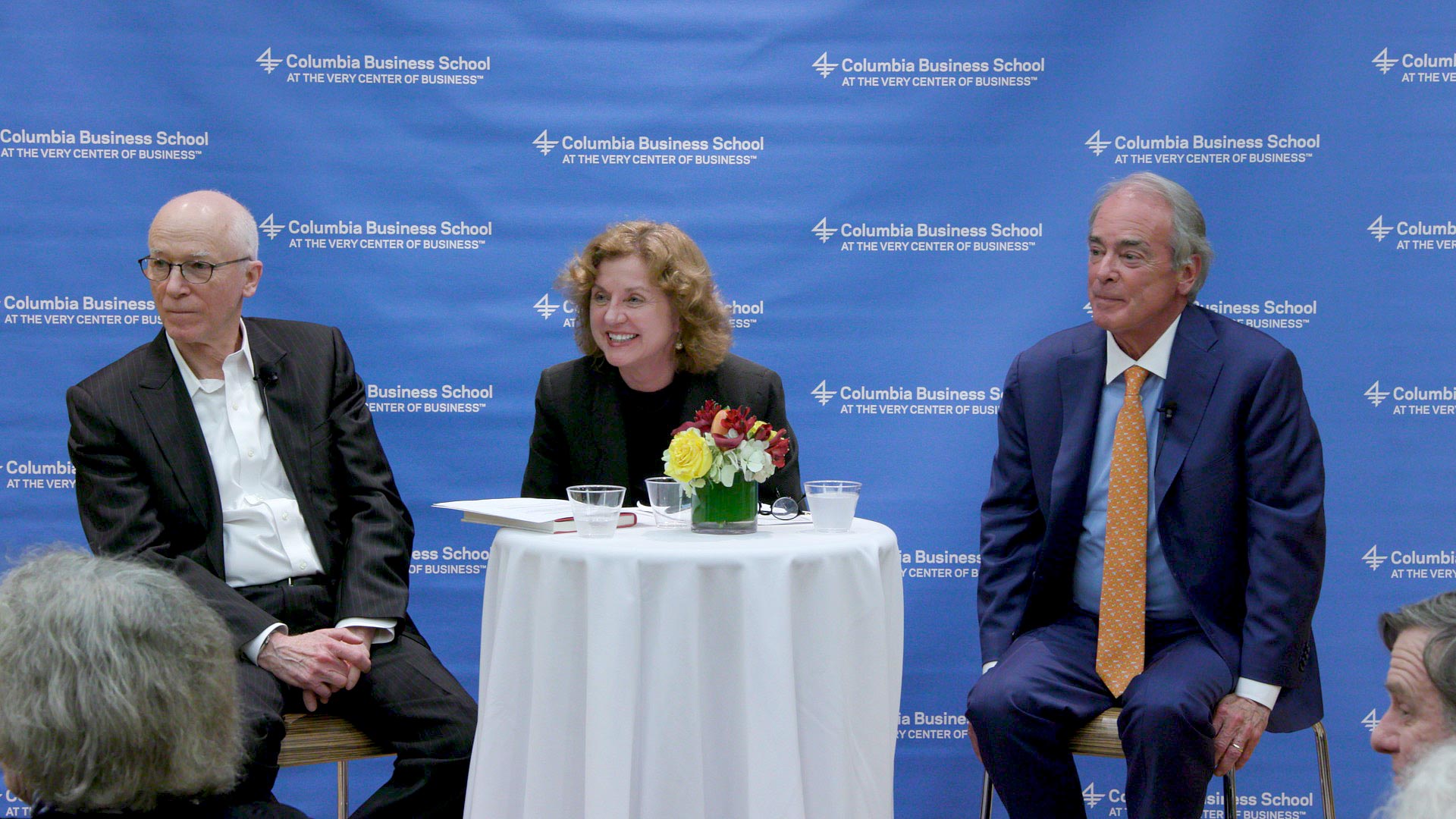
The CN-E 18-80mm Compact Servo in Use
Late last year I spent three days on a corporate project, being a fly on the wall for a meeting of about sixty people as they heard from speakers, broke into groups, and made presentations of their own. For that assignment my camera position was fixed throughout each day. On a certain level it’s hard to convey unless you use the lens on your own but in that type of scenario the CN-E 18-80mm’s ease of use was truly amazing.
First, the reach of the CN-E 18-80mm was more than enough to get individual participants and wide shots of the room. Second, I could operate the lens and the camera in ways that are just not possible with non-cinema non-servo lenses.
Anticipating my being locked to sticks all day, I rigged the camera so that I could move the fluid head with my right hand while using my left hand to control the lens’ zoom via its servo grip. This gave me control of the camera’s position and the lens’ focal length but what to do about focus while filming? For that I relied on the C300 Mark II’s Dual-Pixel AF Face Tracking to hold focus and I can say that it all worked seamlessly. I could operate, zoom in and out, and be assured of staying in focus.
Had I been using a 24-105mm f/4L IS lens my exposure would have changed as I zoomed and my manual zooms would never have been smooth. Had I been using a manual cinema zoom lens, it would have been impossible. I would have needed at least one assistant to help rack the zoom or set the focus as I moved the camera.
For this project, the CN-E 18-80mm Compact Servo lens definitely upped the production value of my work. The client needed a ready-to-air video and by using the CN-E 18-80mm lens I could zoom to speakers as needed, back out to show the room, finesse the zoom speed with the lens’ servo grip, and hold focus even if a speaker or a participant was moving about the room, all as a one-man band.
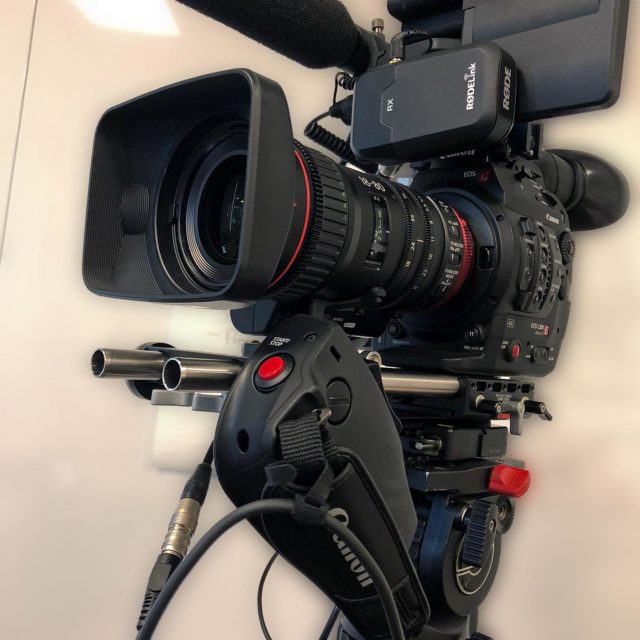
CN-E 18-80mm Compact Servo Lens Criticisms – Real and Imagined
But it’s a T4.4…. it is. That’s an f/4 equivalent and it is what it is. If you need faster then the CN-E 18-80mm lens isn’t the lens you are looking for. The tradeoff with the CN-E is to size, weight, and cost. You can have faster but it will be bigger, heavier, and cost a lot more. Five times as much for a Canon T2.9 17-120mm Cine-Servo zoom lens, eight times as much for an all manual CN-E 14.5-60mm T2.6 zoom lens. The weight of each of those lenses is about three times as much, and five times as much as a CN-E 18-80mm respectively.
There are now other options available for cinema zooms… There are and some are a bit faster but the same trade-offs I just mentioned remain. For example, the Zeiss 21-100mm lens is all manual but it costs twice as much and it weighs almost twice as much. It also has a variable T stop, T2.9-3.9. It’s a great lens but it is really a different type of lens. The Angenieux EZ-1 30-90mm S35 Cinema Lens is similar. It is two-stops faster and has a fixed T2.0 aperture, but it is not quite the same focal length, weak on the wide end, it costs twice as much, and it’s fully manual.
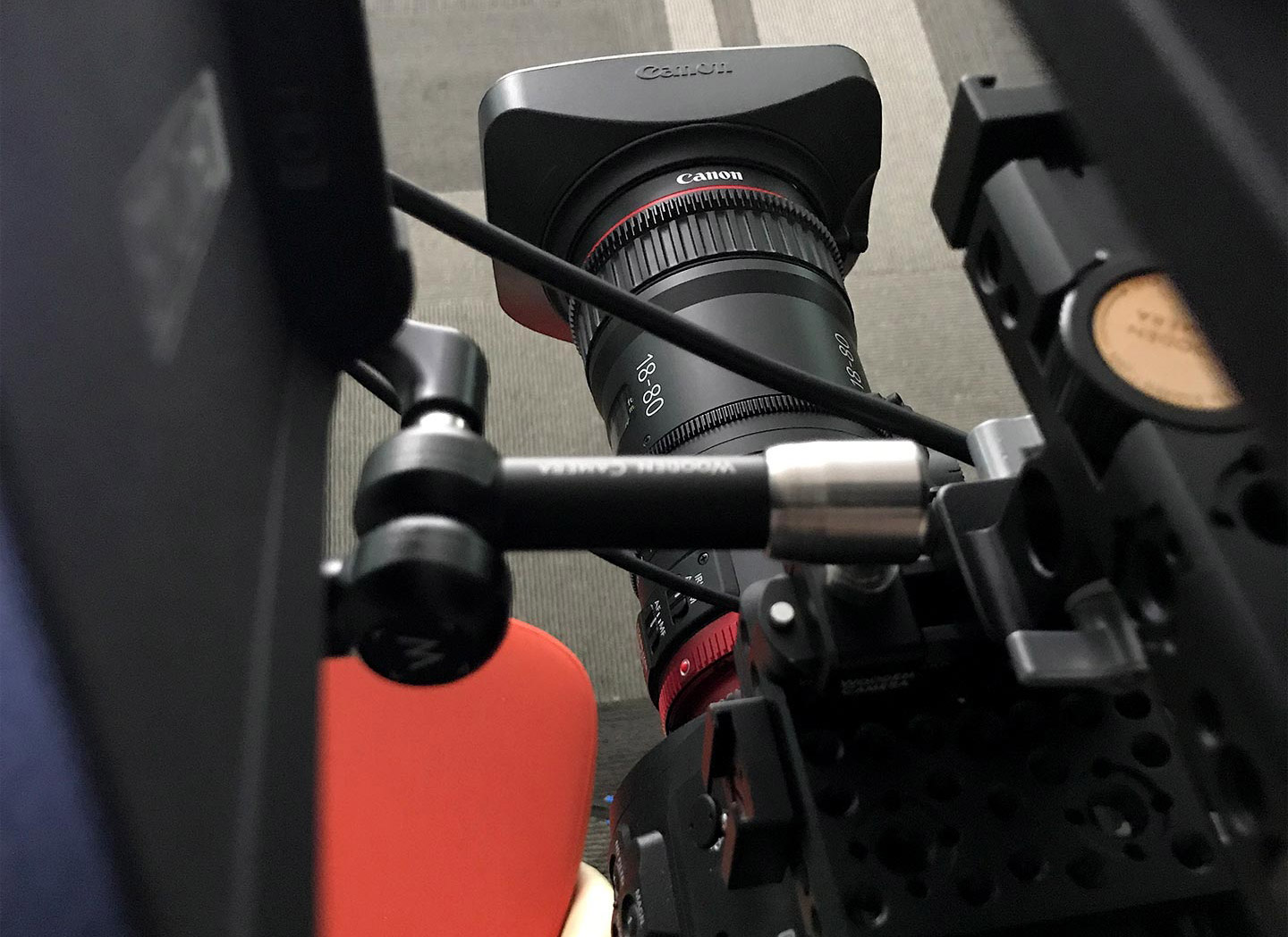
But it has no hard stops…. It does not but first some background. A traditional cinema lens is manual focus, like the two I just mentioned, and it has hard stops. This means it cannot go beyond the beginning or the end points of the focus throw. This makes it possible for camera operators or focus pullers to set near and far focus points and to execute repeatable focus throws. An autofocus lens in comparison needs freer movement internally to focus efficiently and because of that it can spin indefinitely.
The CN-E 18-80mm lens is a hybrid of Canon’s stills line and its cinema line. It takes elements from each. From the cinema line it orients its lens markings, settings, and readings on the side of the lens barrel, like a cinema lens, and unlike a stills lens which keeps that information on top. It also has built in gears for zoom, focus, and aperture, again like a cinema lens. And lastly, like a cinema lens, the CN-E 18-80mm lens has a de-clicked aperture ring for smooth aperture changes. One truly hybrid feature of the lens is that its aperture can be controlled manually or electronically in auto mode via a Canon cinema camera’s control dials.
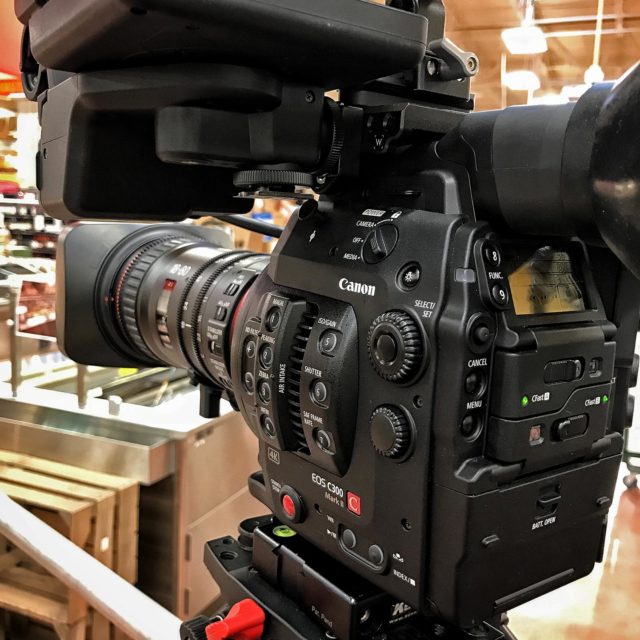
The CN-E 18-80mm’s autofocus though is not a hybrid. It is from the stills side of the fence. It is AF or manual and it has no hard stops. This is not good for narrative film making where actors and focus-pullers need to repeatedly hit marks. In that case, you would be better off with a manual focus cinema lens.
The CN-E 18-80mm, though, still has a trick up its sleeve, it has amazing auto-focus. It can take full advantage of Canon’s Dual-pixel AF, tracking, and face-tracking features. This is great for one-man band situations like I described above. So, no hard stops but it has the ability to excel in other areas where a hard-stopped lens cannot compete.
One note about the CN-E 18-80mm and its manual focus abilities. Most AF lenses are pretty poor at manual focus. Their focus throws are way to short and their manual focus movement is very fiddly. The CN-E 18-80mm lens does tip its hat here to the cinema line. Its manual focus mode is better than most any AF lens. It has a longer focus throw and its manual focus movement is slightly dampened giving it a bit of resistance. This makes the CN-E 18-80mm lens easier to focus manually than most any AF lens.
Canon should include the servo grip with the lens, the ZSG-C10… Yes, they should and they currently are but that’s a promotion which has been running since late last fall, was reinstated for this winter, and the future of it is unknown. The lens does come with a built-in servo controller which can be run from two buttons on the lens or via a Canon Cinema Camera’s joystick. That’s helpful but it’s not the entire story. Operating the lens that way you can set the speed of the zoom but you cannot ramp it in or out or change it on the fly. The accessory servo grip has a zoom rocker like an ENG lens. You can fully control the speed and finesse it as needed from the grip. The grip also adds a record button and a push-AF button (I wish it also had a joystick and aperture dial to better replicate the camera’s side grip.) And as important, the servo grip also has an Arri style rosette mount so you can place it pretty much anywhere.
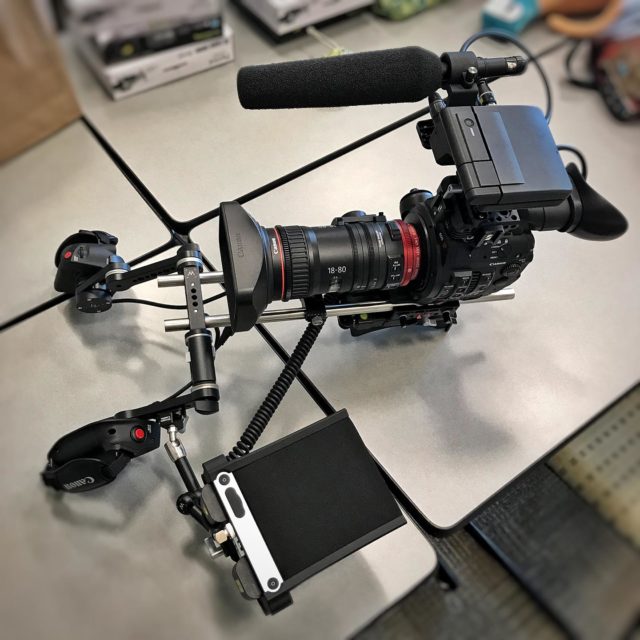
The servo grip’s cable is poorly designed… It is. It has a plug which sticks straight out from the lens in effect shortening its length and possibly opening the cable or lens to damage if you set the camera down in the wrong way. The latter will depend upon how you kit out your camera. If your camera has a base plate and rails it may not be an issue.
The grip, cable, and lens catch-22… If you want to use the grip off of the lens or avoid the servo grip’s power plug sticking out you’ll need Zacuto’s right-angle adapter. It’s a $360 6″ cable extender with a right-angle plug. It works and it’s pretty much a necessity if you want to use the servo grip off of the lens. That’s one catch. A second catch is a lens support. Canon is of the opinion that if you are not using the servo grip attached to the rosette on the lens (the on-lens rosette is an attachment which is part of the servo grip kit) then you do not need a lens support. But what if you want to use a lens support? Well, it is pretty much impossible to use a generic lens support because the lens’ built-in servo motor gets in the way. So, you need Canon’s OEM lens support post and as of last winter Canon does not sell the lens support post on its own. Canon’s lens support post is only sold as part of the servo grip kit. If you want lens support then you have to get the servo grip. It’s not an issue if Canon continues to include a free servo grip kit with each lens but Canon really should include the lens support post with the lens purchase, not as an item only available in the servo grip kit.

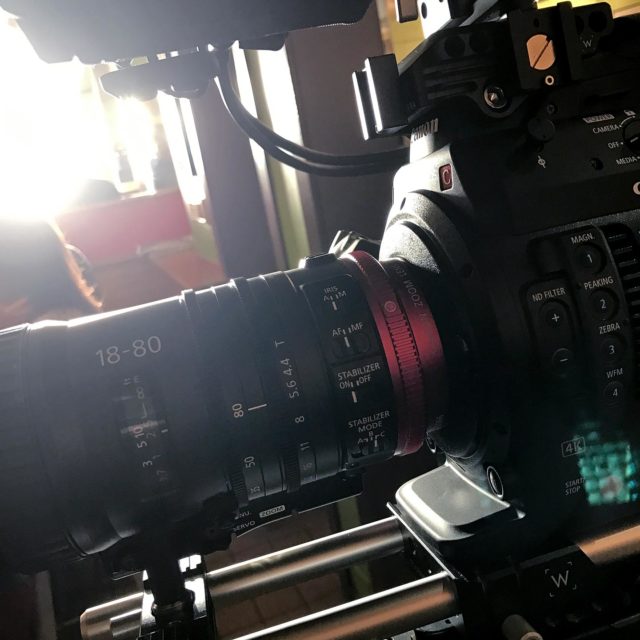
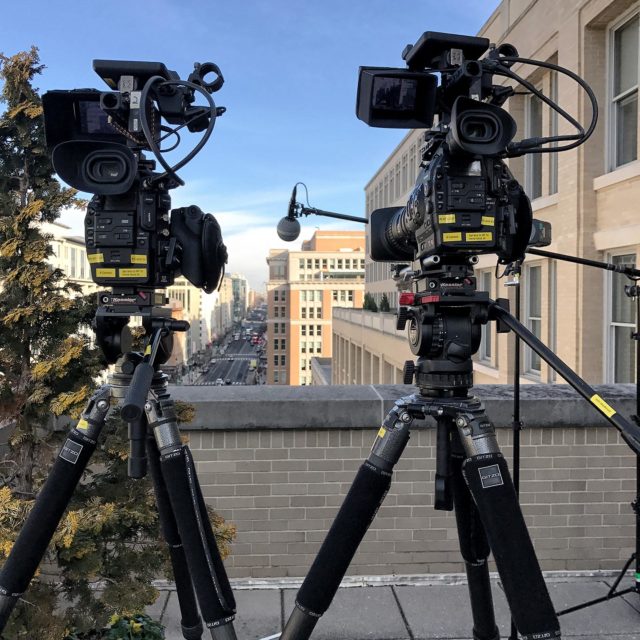

Here are links to two videos by Canon Technical Advisor Brent Ramsey. I was fortunate to work on the studio portions of these videos. Brent’s CN-E 18-80mm sample footage gives a great sense of the lens’ image quality, focus racking, and skin tone rendering. His 1:1 comparison between the 18-80mm lens and Canon’s 24-105mm f/4L IS lens highlights the differences in image quality between the two lenses.
—
I have referred to the CN-E 18-80mm multiple times on this blog: Spinning Wheel Got to Go Round, Two Camera Office Interview: Senator George J. Mitchell, Why Light? Part 2 – The Interview, Why Light? Video Interview Lighting Setup, Faculty Chairs & Backdrop Extensions, Celebrating Service at Princeton, and in Canon C300 Mark II.
Online: Cinematographer Matt Porwoll has an excellent look at the lens as part of his Behind the Lens series for Abel Cine and Newsshooter. DP Erik Naso just completed a review of the newer Canon CN-E 70-200mm T4.4 Compact Servo lens for Newsshooter and much of that review’s comments on the functionality of the 70-200mm lens will apply to the 18-80mm lens. DP Dan Brockett has a review of the 18-80mm lens and a look at both the 18-80mm and 70-200mm over a HDVideoPro.
—
Update 06/25/20: I have a look at the sister lens to the 18-80mm, the CN-E 70-200mm T4.4, in a new post including a lens breathing test.
I also have a look at both lenses on the new Canon C500 Mark II full-frame camera.
